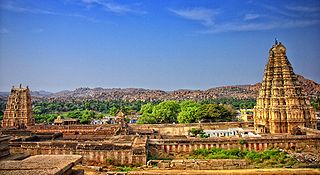
Hampi or Hampe, also referred to as the Group of Monuments at Hampi, is a UNESCO World Heritage Site located in Hampi (City), Ballari district now Vijayanagara district, east-central Karnataka, India. Hampi predates the Vijayanagara Empire; it is mentioned in the Ramayana and the Puranas of Hinduism as Pampa Devi Tirtha Kshetra. Hampi continues as a religious centre, with the Virupaksha Temple, an active Adi Shankara-linked monastery and various monuments belonging to the old city.

Vijayanagara was a city at the modern location of Hampi, in the Indian state of Karnataka. Vijayanagara was the capital city of the historic Vijayanagara Empire. Located on the banks of the Tungabhadra River, it spread over a large area and included sites in the Vijayanagara district, the Ballari district, and others around these districts. A part of Vijayanagara ruins known as the Group of Monuments at Hampi has been designated as a UNESCO World Heritage Site.
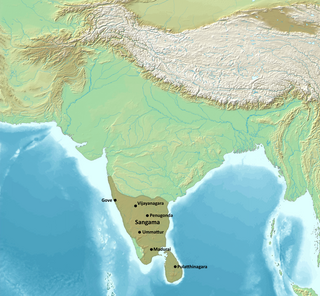
The Vijayanagara Empire was a medieval Indian empire that covered much of the region of Southern India, ruling the lands of the modern states of Karnataka, Andhra Pradesh, Tamil Nadu, Kerala, Goa, and some parts of Telangana and Maharashtra. It was established in 1336 by the brothers Harihara I and Bukka Raya I of the Sangama dynasty, members of a pastoralist cowherd community that claimed Yadava lineage. The empire rose to prominence as a culmination of attempts by the southern powers to ward off Turco-Persian Muslim invasions by the end of the 13th century. At its peak, it conquered almost all of Southern India's ruling dynasties and pushed the Turco-Persian sultans of the Deccan beyond the Tungabhadra-Krishna river doab region, in addition to annexing Gajapati Empire (Odisha) till Krishna river, thus becoming a notable power.

The Tungabhadra River is a river in India that starts and flows through the state of Karnataka during most of its course, Andhra Pradesh and ultimately joining the Krishna River near Murvakonda in Andhra Pradesh

Hospet or Hosapete is the largest and fastest-growing industrial city and district headquarters of the Vijayanagara district in the Indian state of Karnataka. Hospet is known as "the steel city of Karnataka". It is located on the banks of the Tungabhadra River and is 13 km (8.1 mi) from Hampi (Vijayanagar). Hampi was once the capital of the Vijayanagara Empire. It has been designated a UNESCO World Heritage Site. Hospet is the connecting link between North and South Karnataka. It is 333 km (207 mi) from the state capital Bengaluru.

North Karnataka is a geographical region in Deccan plateau from 300 to 730 metres elevation that constitutes the region of the Karnataka state in India and the region consists of 13 districts. It is drained by the Krishna River and its tributaries the Bhima, Ghataprabha, Malaprabha, and Tungabhadra. North Karnataka lies within the Deccan thorn scrub forests ecoregion, which extends north into eastern Maharashtra.
Gangavati is a city, municipality and taluk in the Koppal district of the Indian state of Karnataka. It is one of the main commercial hubs in the Kalyana-Karnataka region. It is also the largest city, in terms of area and population, in the Koppal district.

Virupaksha Temple is located in Hampi in the Vijayanagara district of Karnataka, India. It is part of the Group of Monuments at Hampi, designated as a UNESCO World Heritage Site. The temple is dedicated to Sri Virupaksha, a form of Shiva. The temple was built by Lakkan Dandesha, a nayaka (chieftain) under the ruler Deva Raya II also known as Prauda Deva Raya of the Vijayanagara Empire.

Vijayanagara architecture of 1336–1565 CE was a notable building idiom that developed during the rule of the imperial Hindu Vijayanagara Empire. The empire ruled South India, from their regal capital at Vijayanagara, on the banks of the Tungabhadra River in modern Karnataka, India. The empire built temples, monuments, palaces and other structures across South India, with the largest concentration in its capital. The monuments in and around Hampi, in the Vijayanagara district, are listed as a UNESCO World Heritage Site.

Mysore Dasara is the Nadahabba of the state of Karnataka in India. It is a 10-day festival, starting with nine nights called Navaratri and the last day being Vijayadashami. The festival is observed on the tenth day in the Hindu calendar month of Ashvina, which typically falls in the Gregorian months of September and October.

Dravidian architecture, or the Southern Indian temple style, is an architectural idiom in Hindu temple architecture that emerged from Southern India, reaching its final form by the sixteenth century.
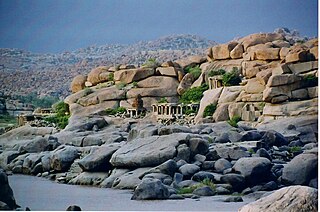
The City of Vijayanagara was the urban core of the imperial city and the surrounding principalities of the capital of the Vijayanagara empire during the 14th century to 16th century CE. Notes by foreign travellers such as Abdur Razzak, the Persian who visited Vijayanagara in 1440, mention seven fortifications before the gates to the royal palace. The large area between the first and third fortifications contained agricultural fields, gardens and residences. The notes of Robert Sewell describe countless shops and bazaars (markets) filled with people from different nationalities between this fortification and the palace.
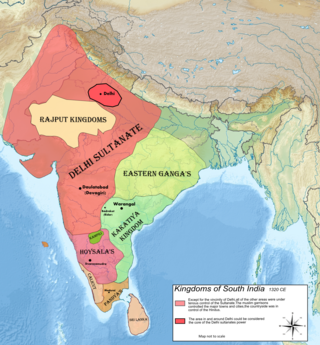
The Kampili kingdom was a short-lived Hindu kingdom of early 14th-century in the Deccan region. The kingdom existed near Ballari and Tungabhadra river in northeastern parts of the present-day Karnataka state, India. It ended after a defeat by the armies of Delhi Sultanate, and a jauhar in 1327/28 CE when it faced a certain defeat. The Kampili kingdom in some historical accounts is called the Basnaga kingdom, and as what inspired and ultimately led to the Hindu Vijayanagara Empire.

Anegundi, previously called Kishkindha, is a village in Gangavathi, Koppal district, in the Indian state of Karnataka. It is older than Hampi, situated on the northern bank of the Tungabhadra River. Nimvapuram, a nearby village, has a mount of ash believed to be the cremated remains of the monkey king Vaali.

Pampa Sarovara is a lake in Koppal district near Hampi in Karnataka. To the south of the Tungabhadra River, it is considered sacred by Hindus and is one of the five sacred sarovars, or lakes in India. According to Hindu theology, there are five sacred lakes; collectively called Panch Sarovar; Mansarovar, Bindu Sarovar, Narayan Sarovar, Pampa Sarovar and Pushkar Sarovar. They are also mentioned in Shrimad Bhagavata Purana. In Hindu scriptures Pampa Sarovar is regarded as the place where Pampa, a form of Shiva's consort Parvati, performed penance to show her devotion to Shiva. It is also one of the Sarovar's that finds a mention in the Hindu epic, Ramayana as the place where Shabari, a devotee of Rama waited for the arrival of Ram.
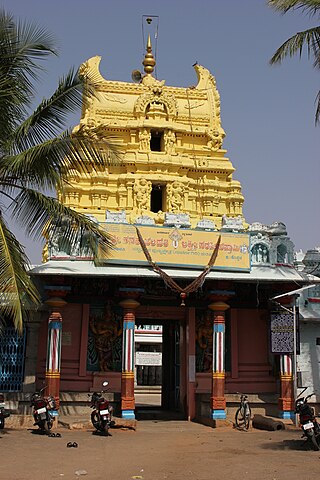
The Kanakachalapathi temple is a 16th-century Hindu temple dedicated to the god Vishnu. It is located in the town of Kanakagiri, in the Gangavathi taluk of Koppal district in the Karnataka state, India. Kanakagiri, known in ancient times as "Swarnagiri" is about 3 km from the district headquarters Koppal city, 380 km north of Bangalore city and 200 km east of Belagavi city.

Hampi or Vijayanagara is a city in the Vijayanagara district in the Indian state of Karnataka. Located along the Tungabhadra River in the east and center part of the state, Hampi is near the city of Hosapete. It is famous for hosting the Hampi Group of Monuments, a UNESCO World Heritage Site.
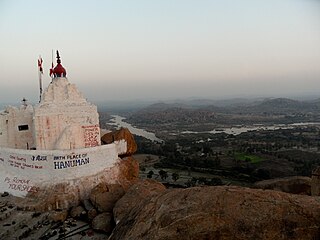
The Yantrodharaka Hanuman Temple, is a Hindu temple dedicated to Hanuman which is situated in the town of Hampi, Karnataka, India. The shrine of Yantrodaraka Hanuman was eulogised by Vyasaraya a Madhva saint. There is a temple dedicated to Lord Rama called Kodandarama Temple near the Hanuman temple which stands as an evidence of Rama's and Hanuman's union in this place. The temple is located at hill top on the banks of Tungabhadra River in Hampi, Karnataka. Legend also says that, Lord Rama and Hanuman met for the first time here on a hill called Malyavana hill.

Vijayanagara district is a district in the southern Indian state of Karnataka, located in the Kalyana-Karnataka region. The city of Vijayanagara is its headquarters.






















